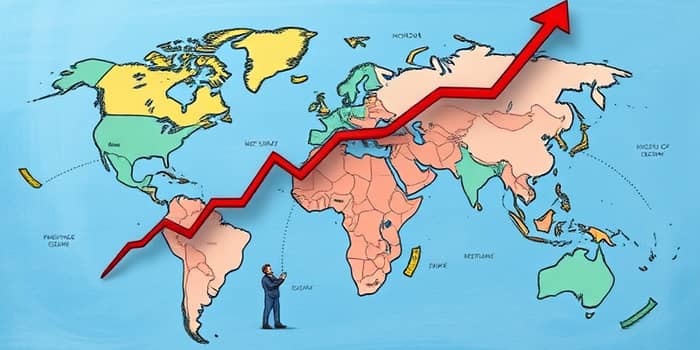
The global financial landscape is undergoing a period of rapid transformation. Rising inflation, shifting trade policies, and evolving monetary stances have converged to send bond yields soaring. For investors, businesses, and households alike, this surge presents both challenges and opportunities. Understanding the forces at play and adopting practical strategies can help navigate these turbulent times and ensure more resilient financial outcomes.
In 2025, the benchmark 10-year U.S. Treasury yield has oscillated between 3.8% and 4.2%, briefly peaking above 4.5% in April. Meanwhile, the 30-year Treasury yield has climbed past 5%, levels unseen since 2007. This dramatic upward movement reflects markets grappling with persistent global inflationary pressures and uncertainty over future monetary policy.
Bond yields move inversely to prices: as investors demand higher returns for lending their capital, yields rise. Recently, concerns about a potential resurgence in inflation—driven by supply chain disruptions, wage growth, and tariff-related cost increases—have prompted investors to require steeper compensation for locking in long-term debt. This dynamic underscores a fundamental recalibration in expectations for both risk and return across fixed-income markets.
Inflation remains at the forefront of economic discourse. The Federal Reserve’s preferred gauge, the Personal Consumption Expenditures (PCE) index, is projected at 3.0% for 2025, with a gradual decline to 2.4% by 2026 and 2.1% by 2027. Core PCE, which strips out volatile food and energy prices, is expected to follow a similar trajectory.
Compounding these trends are looming tariff policies. Analysts estimate that new tariffs could add between 0.75 and 1.5 percentage points to year-over-year inflation by late 2025. These measures, intended to protect domestic industries, can inadvertently amplify consumer prices. The resulting cost-push inflation forces central banks and market participants into a delicate balancing act between growth and price stability.
Against this backdrop, the Federal Reserve has maintained its federal funds rate at 4.50%, signaling a higher-for-longer monetary policy stance. Market-implied probabilities suggest a 77% chance of a rate hold in the July 2025 FOMC meeting. Traders and economists are closely watching incoming data to gauge whether the Fed will pivot to rate cuts as early as September if inflation moderates and growth softens.
Volatility has surged alongside yields. The MOVE index, which tracks Treasury market fluctuations, spiked sharply in April amid rapid policy shifts and geopolitical developments. This spike underscores how quickly market sentiment can shift when investors reassess the trajectory of inflation and interest rates.
As bond yields climb, borrowing costs rise across the economy. Homeowners face more expensive mortgage rates, while corporations see higher interest payments on new debt. For many households, this can translate into tighter budgets and recalibrated spending plans. Businesses may postpone expansion or capital projects in response to the increased cost of financing.
On the investment side, rising yields can dampen stock valuations, particularly in rate-sensitive sectors such as technology and utilities. Yet, some equities may benefit from improving economic growth prospects if the yield surge reflects a healthy expansion rather than runaway inflation. In this environment, balanced and diversified portfolios are crucial for managing risk and capturing opportunities.
While the outlook may appear daunting, there are practical steps that can foster financial resilience. By adopting robust risk management strategies and focusing on long-term goals, investors and borrowers can navigate the current volatility with greater confidence.
For corporate treasurers and financial officers, scenario planning and stress testing can illuminate potential balance sheet vulnerabilities. Engaging in proactive debt management—such as locking in rates for key funding requirements—can mitigate the impact of further yield spikes.
Long-term investors may find that market corrections, triggered by rapid yield adjustments, present attractive entry points in high-quality assets. By adhering to resilient financial planning principles, individuals and institutions can transform uncertainty into strategic advantage.
Market participants are weighing forecasts of one or two Fed rate cuts beginning in late 2025 against the possibility of a prolonged period of elevated rates. A “higher-for-longer” paradigm could become the new norm if inflation proves stickier than anticipated, debt levels remain elevated, and central banks prioritize price stability.
Governments also face mounting challenges. With the U.S. debt-to-GDP ratio near 100%, fiscal policy decisions—including proposed tax changes and spending bills—could influence future borrowing costs. Investors may demand even higher yields if they perceive growing risks to fiscal sustainability.
Despite these uncertainties, opportunities abound. Savvy investors can capitalize on attractive yields in the fixed-income market, while borrowers with strong credit profiles may negotiate favorable financing terms before rates climb further. Businesses that optimize operational efficiencies and manage costs can thrive even in a higher-rate environment.
The recent spike in bond yields reflects a complex interplay of rising borrowing costs squeeze budgets, inflation expectations, and evolving monetary policy. While the immediate outlook may feel challenging, a thoughtful, disciplined approach can uncover opportunities and strengthen financial resilience.
By staying informed, embracing flexible strategies, and focusing on long-term objectives, investors and borrowers can weather the storm of volatility. The current moment is not simply one of risk—it is also a time for strategic adaptation and renewed clarity. As markets adjust to new realities, those who blend prudence with foresight will be best positioned to thrive in the years ahead.
References













